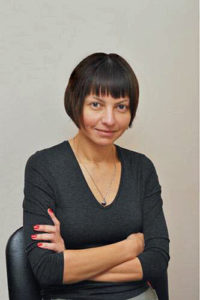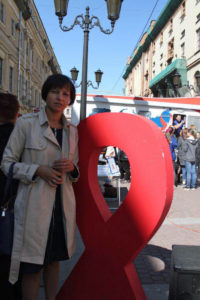
Author: Anastasiya Petrova, Russia
Last year a major event in the field of HIV in Russia became the adoption of the National strategies of counteraction with the spread of HIV-infection in the Russian Federation until 2020. One of the key objectives of the Strategy was the consolidation of efforts of governmental and nonprofit organizations in their fight against the epidemic. Today we discuss the implementation of this interaction in the most progressive city of Russia with the Deputy chief physician of St. Petersburg Center for prevention and control of AIDS and infectious diseases, holder of Doctoral degree in Medicine, third-generation doctor Tatiana Vinogradova.
– Tatiana, do you support the idea of implementation of cross sectoral programs on HIV prevention among vulnerable groups in cooperation with socially oriented non-profit organizations?
– In addition to the scientific-organizational work in the AIDS Center, I am responsible for the interaction with public organizations in the context of HIV-infection in Saint-Petersburg. I think, this is very important. HIV is a socially sensitive disease, and groups of HIV vulnerable people – people who inject drugs, men who have sex with men, sex workers – usually are not easy to approach. I am deeply convinced that only nonprofit organizations, organizations that deal with this issue and have experience in the field, are able to work with the key groups. Even if we have an opportunity to send “a man in a white coat” to interact with these key groups, there is no guarantee that this health worker will be accepted and will be able to perform all the necessary tasks. Nonprofit organizations have access to these closed groups, they are able to work on the principle “peer to peer.” Representatives of vulnerable groups perceive them appropriately and they are able to provide medical assistance as well. This is the most important! We can find a lot of new HIV-cases by testing a large number of people, but when we test the general population or key populations, our work is not limited with testing and identifying, we also should provide medical support. Peer consultants and employees of nonprofit organizations are the best in this field.
– How does the Center for prevention and control of AIDS and infectious diseases cooperate with NGOs? Is there any model or mechanisms?
– AIDS Center in St. Petersburg works with community organizations from the very first day of its existence. In the beginning, there was no AIDS Center in its modern sense, but there was an office based in Botkin hospital, which started this interaction. The first nonprofit organization was registered by Nikolay Panchenko. Therefore, we can say, that here in St.-Petersburg we already have thirty years of cooperation experience between public institutions and community organizations. We work together since the early 90’s.
Committee on health care through the Center for prevention and control of AIDS and infectious diseases provides financial support for the HIV prevention offices, which work in the city. Nowadays there are four such offices based on public medical institutions. These offices work in close cooperation with community organizations that employ peer consultants. Together with nonprofit organizations we conduct events, various events like testing days, for instance. Nonprofit organizations also hold round tables, press conferences, which our doctors always attend.
Nonprofit organizations also participate in the Coordinating Council affiliated to the government of St. Petersburg. This Council consists of the leaders of the organizations representing each of the key groups: those who work with people who inject drugs, or with women, or who provide legal support. In our city, the Health Committee as well as the Committee on social policy work in cooperation with NGOs in the context of HIV infection. I do not think there is another similar model in other regions. NGOs in Saint-Petersburg receive grants and funding not only from health but also from social policy institutions. There are many offices across the city, where peer consultants officially and legally work with the vulnerable groups, provide them support and accompany them to the AIDS Center.
 – It seems to me, that we have adopted a western model of interaction, is it true?
– It seems to me, that we have adopted a western model of interaction, is it true?
– Yes. Basically HIV-infection appeared in Russia later than in Western Europe and the United States. Why to reinvent the wheel, if there is already some experience that can be used? I remember in the late 90s – early 2000s, when the first wave of HIV-infection started, and it spreaded very quickly among people who inject drugs. In one year 10,000 cases were found. At that time, it was something terrible. People were dying. At that time, it was a fatal diagnosis. Then the first bus appeared on the basis of the AIDS Centre, and our head nurse Marina Petrova was sitting in that bus nearby the metro station Gostiny Dvor, taking blood. Back at the time there were no rapid tests, and no one could predict that they will once appear. We used test tubes. This work was done in cooperation with public organizations.
– Are there any effectiveness indicators of such an interaction and what are they?
– Our AIDS center is one of the largest AIDS centers in Russia. 35,000 patients are registered, and a lot of them come from mobile laboratories of local public organizations. There are several organizations in our city that are doing rapid testing and providing counselling about HIV infection. 80% of people, who get their diagnosis during the testing in these organizations, then go and get registered in the AIDS Center. This is very important, because it is not enough just to identify a new case. A person needs some health survey to decide if the therapy is necessary. We must provide some psychological support to help him or her deal with the stress, which is unavoidable when the person learns the diagnosis. We must motivate him or her to be followed up by a doctor. After all, if she or he will be followed up by a doctor, she or he will stay alive. This is the most important thing. If a person receives antiretroviral therapy, he or she does not transmit the virus further. A person lives, and a virus is not spreading.
– The 22nd AIDS conference – AIDS 2018 – will be held in Amsterdam, and the organizers would like to see a wide representation of people from Eastern Europe and Central Asia there. Have you participated in previous conferences and do you plan to attend the next one?
– The first AIDS conference I attended was held in Geneva in 1998. Now I plan to attend the conference in Amsterdam. I already have two ideas for the conference abstracts. During the conference, I would like to get new information about the interaction with public organizations.



